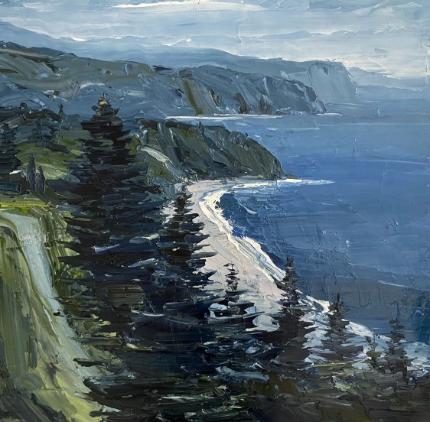Wombarra

David Manks

Campus Art Collection : A Sense of Place


Introduction
Visual Analysis
Wombarra Introduction
Let's explore David Manks stunning artwork entitled Wombarra. This breathtaking painting captures the dramatic beauty of the Wombarra coastline in Australia. Nestled between the majestic escarpment and the serene ocean. As we delve into this piece, I invite you to immerse yourself in its visual elements and reflect on the emotions it evokes.
At first glance, Wombarra presents a captivating landscape that immediately draws the viewer in. The composition is rich with colours and shapes that create a harmonious scene. In the foreground you'll notice a cluster of dark green trees. Their bold brush strokes defining their shapes against the backdrop of rolling hills and lush greenery. These trees frame the painting beautifully, inviting your gaze to journey toward the coastline. The contrast between the rich greens of the foliage and the lighter hues of the sandy beach and ocean creates a sense of balance that is visually pleasing.
As we move further into the artwork, the shoreline unfolds gracefully. A sandy beach curves gently along the coast. Its soft white sand illuminated by sunlight filtering through the clouds. This detail invites the imagination to picture walking along the shoreline, feeling the warm sand beneath your feet.
The ocean itself is painted in deep blues and vibrant turquoises, appearing calm yet powerful, hinting at the vastness and mystery of the sea. Many viewers often find themselves captivated by the tranquil yet dynamic nature of this coastal scene.
In the background, the dramatic cliffs and hills of the escarpment rise majestically, their shapes softened by Mank’s brush work. The layers of green and blue create depth, suggesting a landscape that is both inviting and enigmatic. The distance escarpment shrouded in mist adds an element of intrigue, encouraging viewers to wonder what lies beyond the horizon. This interplay of elements invites contemplation about the relationship between land and sea, as well as the beauty of the natural environment.
The sky above is filled with soft gray clouds that suggest an impending change in weather. This atmospheric quality adds drama to the scene, reminding us of natures unpredictability. The interplay of light and shadow throughout the landscape enhances the overall mood of the painting, creating a dynamic atmosphere that many people find both soothing and thought provoking.
How does this mood resonate with your experience of nature?
As you engage with Wombarra consider your own reactions to the artwork.
What feelings arise as you observe the tranquil yet powerful landscape?
Are there memories or experiences that come to mind when you think of coastal environments?
This painting encourages viewers to connect with their personal experiences of nature, fostering a deeper appreciation for the beauty that surrounds us.
In conclusion, Wombarra serves as a beautiful homage to the natural landscape, showcasing the essence of the Wombarra coastline. Through Mank’s, skillful use of colour, texture and composition, the artwork invites viewers to reflect on the power of the landscape and our relationship with it. It reminds us of the importance of preserving such stunning environments for future generations. The painting evokes thought and dialogue about our place within the natural world, encouraging us to appreciate the intricate beauty of landscapes like Wombarra.
Thank you for joining me on this exploration of David Mank's remarkable work.
As you leave, I encourage you to carry these reflections with you and think about how art can deepen our connection to nature and inspire us to protect the environments which cherish.
Wombarra visual analysis
Today, we're going to take a closer look at David Manks’ stunning painting Wombarra.
As we analyze this artwork, we will explore the visual elements and principles of design that come together to create its impactful composition. Let's start by closely observing the painting, taking note of all the visual components without jumping into interpretations just yet. In Wombarra, you'll notice a beautiful coastal landscape characterized by a sweeping view of the ocean meeting the land.
The first thing that catches the eye is the dynamic interplay of colours. The artist employs a rich palace dominated by blues, greens and earth tones, creating a sense of depth and tranquility. The varying shades of blue not only represent the ocean and sky but also evoke a feeling of calmness and serenity. Meanwhile, darker greens and browns in the foreground, add a sense of grounding to the scene.
Now as we analyze the specific elements of art, let's begin with line. The lines in this painting are primarily organic, with gentle curves that mimic the natural contours of the coastline and the rolling hills. The trees in the foreground have jagged, irregular lines that contrast with the smooth flowing lines of the beach and ocean. These lines guide the viewers eye across the canvas, inviting them to explore the landscape. You might find yourself tracing the outline of the coastline moving from the forested area down to the sandy shore.
Next, let's consider shape. In Wombarra, there's a mix of both geometric and organic shapes. The cliffs and the horizon create a clear horizontal line while the trees introduce vertical shapes that add height and depth. The arrangement of these shapes enhances the composition as the organic forms of the trees contrast beautifully with the geometric nature of the land and sea. This interaction creates a harmonious balance within the artwork.
Now let's dive into colour. The colour palette is one of the most striking aspects of this painting. The dominant blues evoke feelings of tranquility and peace, while the greens of the trees suggest vitality and growth. The artist uses analogous colours, those that are next to each other on the colour wheel, creating a soothing effect. Additionally, the contrast between the deep colours of the forest and the lighter hues of the beach draws attention to the shoreline, making it a focal point of the composition.
How do you feel when you look at these colours together?
Texture also plays a significant role in Wombarra. The brush strokes are visible and create a sense of depth and movement, giving the painting a tactile quality. The rough texture of the trees contrasts with the smoothness of the water, enhancing the overall visual experience. This texture adds layers to the artwork, inviting viewers to not only see, but almost feel the landscape.
Space is another crucial element in this piece. The artist effectively uses both positive and negative space to create a sense of depth. The trees create a strong positive space in the foreground, while the expanse of ocean and sky occupy the negative space, allowing the viewer to breathe within the composition. The overlapping of the trees and the coastline adds complexity, leading to a layered visual experience.
Now that we've identified these elements, let's shift our focus to the principles of design. First off, we can see that the artwork exhibits asymmetrical balance. The dense forest on one side contrasts with the open space of the beach and ocean on the other, creating an engaging tension. This balance encourages the viewer to explore the entire canvas rather than fixating on one area.
Next, harmony is evident throughout the piece. The recurring colours of blues and greens unify the composition, creating a sense of cohesiveness that ties all the elements together. This unity enhances the overall emotional impact of the artwork, making it feel like a complete expression of its subject.
Contrast is also a key principle in Wombarra. The stark differences between light and dark areas, as well as rough and smooth textures, add visual interest and emphasize certain features such as the shoreline. This contrast draws the viewers attention and creates focal points within the piece.
Speaking of focal points, the beach serves as the primary emphasis in this artwork. The lighter colours and smooth lines of the shoreline naturally attract the eye, guiding the viewer to the point where land meets sea. The arrangement of elements leads the viewers gaze along the coastline, creating a sense of movement throughout the painting.
Finally, let's consider scale and proportion. The trees in the foreground appear larger than the distant cliffs and ocean, creating a sense of depth and drawing the viewer into the scene. This exaggeration enhances the immersive quality of the landscape, making it feel expansive and inviting.
In synthesizing these elements and principles, we can see how they interact to convey meaning and emotion. The combination of organic lines, harmonious colours and balanced composition evokes a sense of peace and connection to nature. Manks’ painting invites viewers to reflect on the beauty of coastal landscapes and our relationship with the environment.